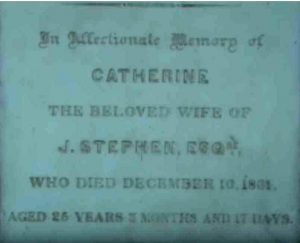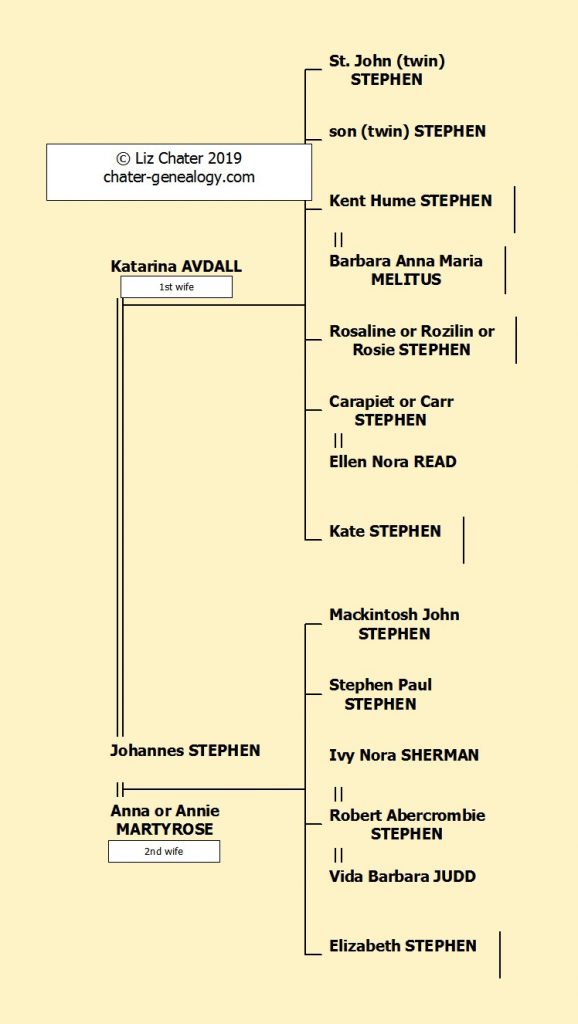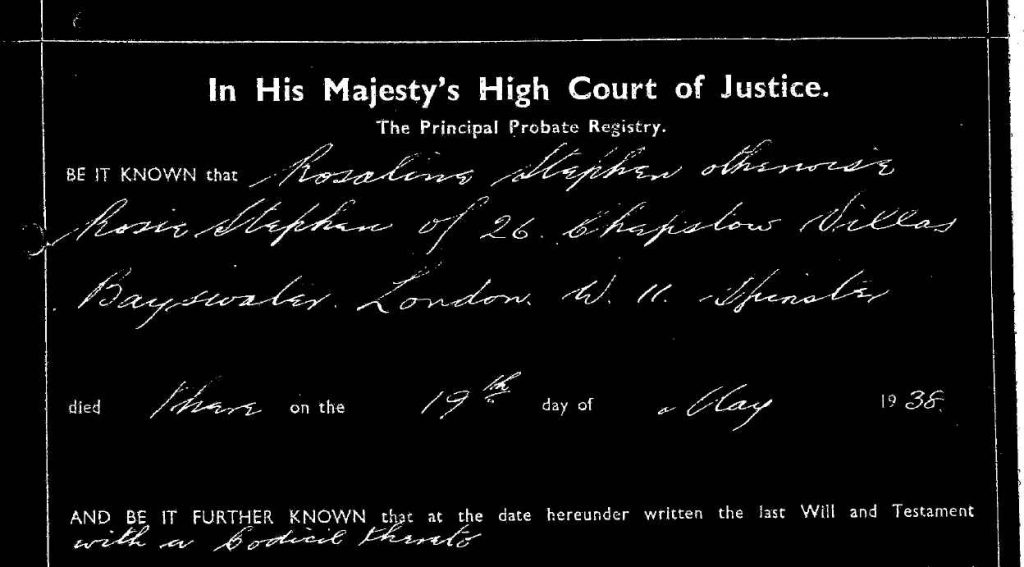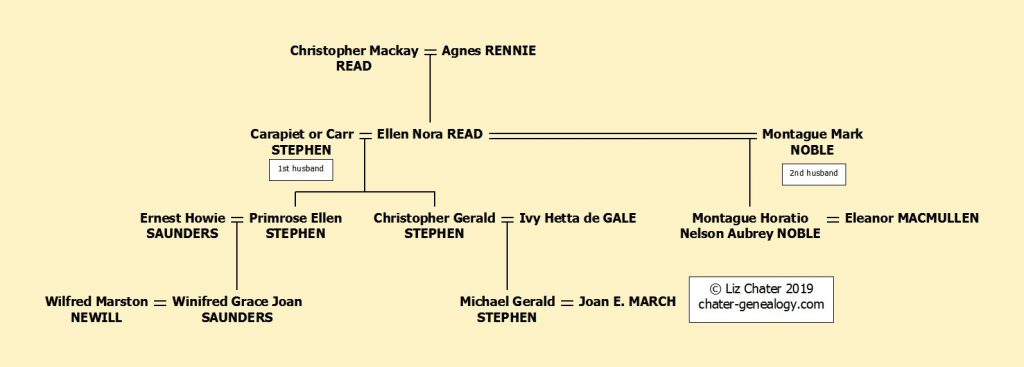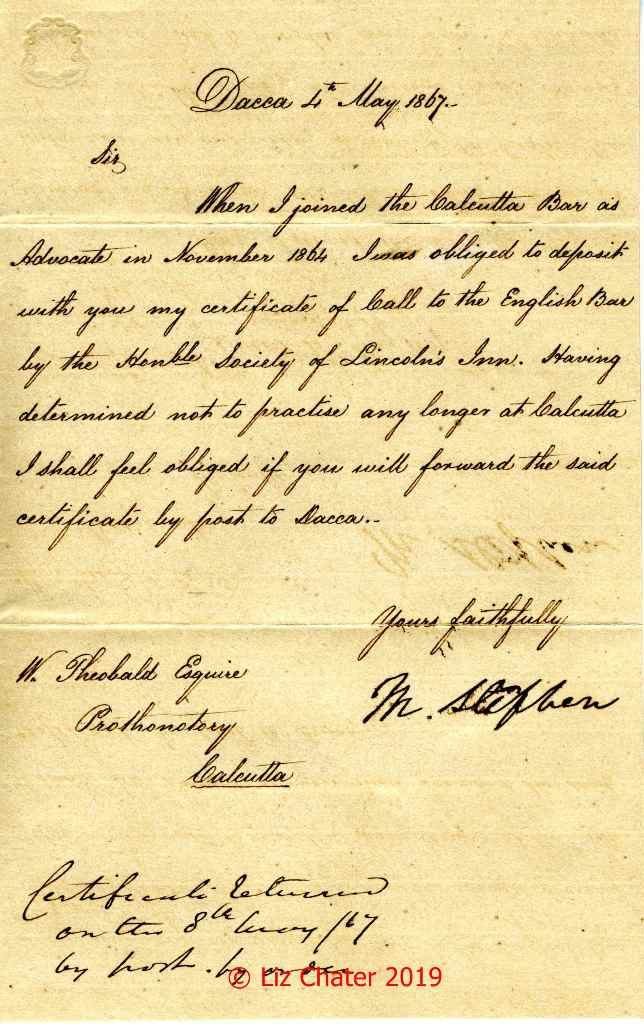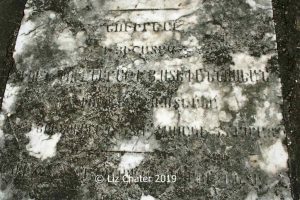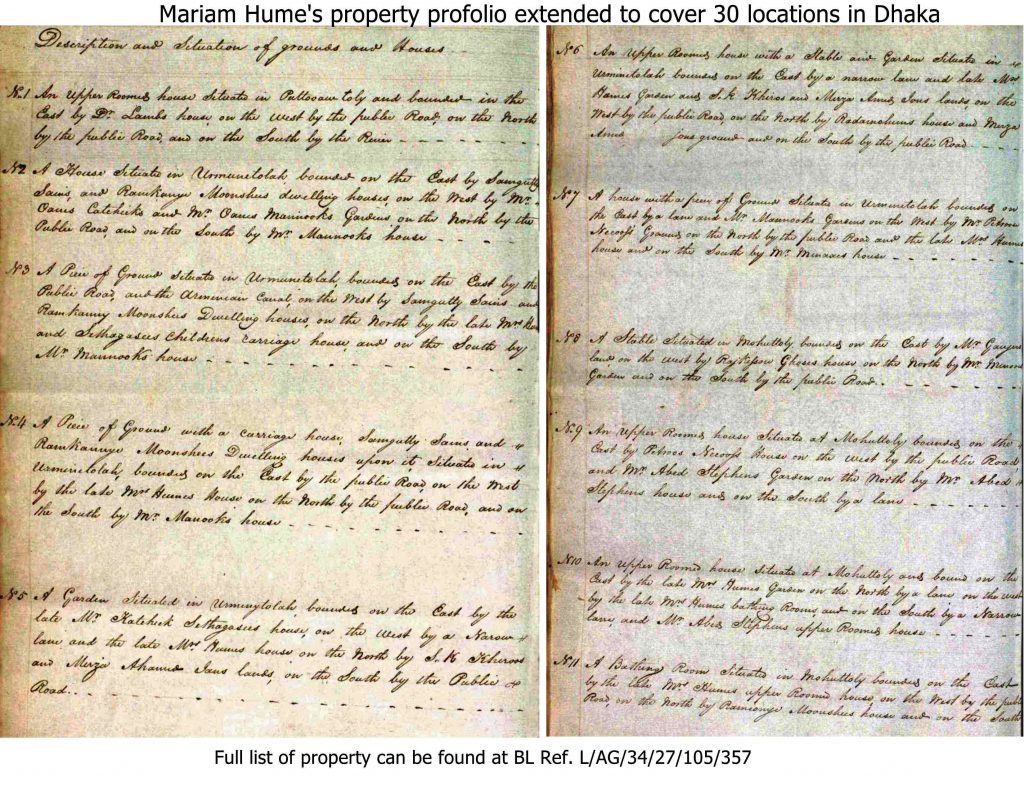Stephen Family of Dacca
The unravelling of family history and their associated stories can sometimes take unusual twists and turns. Armenian family history in Asia is no different. There were only 126 Armenians in Dhaka in 1831 in 42 houses, averaging 3 people per household[1]. Along side them was a small population of Greek residents numbering just 48, the Portuguese community had 144 people and there were just 4 who were French. By contrast there were over 31,000 Hindus and in excess of 35,000 Muslims. The Christian community was negligible.
In an earlier story I uncovered previously unknown information on the founder of the Pogose School in Dhaka, Joaquim Gregory Nicholas Pogose aka Nicky Pogose who married Mariam Avdall the daughter of Johannes Avdall, headmaster of the Armenian College and Philanthropic Academy in Kolkata. Johannes had at least ten children all born in Calcutta. Two other daughters of his also settled in Dacca, having married Armenian merchants of that city.
For those of you who like facts and figures, sources and citations as well as biographical details, this is for you.
One of the other daughters of Johannes Avdall was Catherine Avdall who married another leading Dhaka community member, Zemander, Stephen Johannes Stephen[2]. He quickly dropped his Christian name and was known as Johannes Stephen[3]. Together they had at least five children between 1854 and 1860. After Catherine’s untimely death in 1861[4] aged just 25 years,
Johannes Stephen found himself in the unenviable position of having to care for his young family from infant to aged 7. Johannes remarried for a second time in 1867[5] at the Catholic Church in Dacca to 17 year old Annie Ter Martyrose with whom he went on to have at least four further children.
Their marriage celebrant was Fr. Felix Francis Mari Fortunate Marzuchelli, a charismatic, well travelled Italian priest, who was a Doctor of Philosophy and a Professor of Literature. Fr. Felix had married in 1853 in Geneva, Switzerland to an English young lady from Somerset called Elizabeth Harris.[6] He had been appointed Chaplain at Dacca in April 1867 but stayed only a year or so, before moving to Darjeeling, [7] then later Hazaribagh.[8] Eventually, he and Elizabeth (who was known as Nina) settled in England. The marriage he conducted between Johannes Stephen and Annie would have been one of the first after his arrival in Dacca from England.
By the time Annie was 24 years of age she was looking after Johannes’s nine children from two marriages.
The children Johannes Stephen and Catherine were:
St. John Stephen, a life bachelor who was educated at St. Paul’s Darjeeling, North India. In the autumn of 1873 he travelled to England and from that time up to March 1875, St. John was privately tutored by Mr. Walter Wren, of Powis Square London, who specialised in intensive tuition predominantly preparing students for the British Army. Moving swiftly from Powis Square, St. John commenced his residency at Caius College, Cambridge in October 1875. In June of the following year he was elected a foundation scholar, he went on to achieve first place in all his college examinations each year he was there. Mr. Routh was his private tutor and Rev. N.M. Ferrers his college tutor[11]. He studied law, and was called to the Bar in 1880 at the Inner Temple, London, going on to practice at the High Court, Calcutta[12]. St. John was also a member of Managing Committee of the Armenian College and Philanthropic Academy in Calcutta in 1901, taking a very keen interest in the students and their further education[13]. He died in Calcutta in 1915 of cardiac syncope and is buried in the Lower Circular Road cemetery.[14] In his will he appointed his sisters, Rosie and Kate as executrixes. He bequeathed to his brother Kent, a gold watch that had once belonged to their father Johannes. The remainder of his estate went to Rosie and Kate[15].
- Kent Hume Stephen born in 1856, Dacca[16].
Kent married another Armenian, Barbara Melitus in June 1895 in Kensington, London.[17] Barbara had been born in Calcutta in 1868[18] to Gregory Paul Melitus and Mary née Elias. Through her father’s mother Anna Maria, Barbara can trace her family back to Coja Sultan David Shahmir, an eminent merchant of Madras who was born in Julfa around 1690 and died in 1754 in Pondicherry. Extraordinarily, as a side note, Shahmir’s tombstone was found in 1997 in a ship wreck of an East India vessel “Earl Temple” on the southern edge of Thitu Reef in the South China Sea. It was eventually raised from the deep. Further and more detailed information on how an Armenian gravestone was discovered at the bottom of the ocean can be found in ‘Up from the Watery Deep. The Discovery of an Armenian Gravestone in the South China Sea’ By Susan E. Schopp.
Barbara Melitus’s own maternal line is just as illustrious, her grandfather was Agha Owen John Elias, locally well known in Calcutta as a generous and philanthropic man during his lifetime. A memorial wall plaque inside the Armenian Church Kolkata indicates the high esteem he was held. “Sacred to the memory of the late Owen John Elias Esquire. Born 1st November 1786. Died 12th March 1860. This tablet is erected by the Armenian community of this place as a mark of their appreciation of his private and public virtues. His charities to widows and orphans and the poor will not remain unrewarded in heaven. His gifts to the churches, schools, asylums and hospitals, which have made his name to be generally respected have specially endeared it to his own countrymen.” Remarkably, there are portraits of Agha Owen John Elias and his wife Barbara hanging in a beautiful country house in England, “Chenies Manor” in Buckinghamshire, and, according to their tour guides, are often complimented on by members of the general public who visit the estate.
Meanwhile, in 1875 Kent enrolled in the Royal Indian Engineering College in Staines, Middlesex studying there until July 1878. He gained his first engineering position on the London and North Western Railway between October 1878 and March 1879, then Chatham Water Works between April and August 1879. With this civil engineering experience behind him, he returned to India and was employed with the India Public Works in irrigation for the next 24 years[19], eventually retiring back to England in 1903.
Extraordinarily, our research coordinator, Liz Chater has in her archive, a copy of the original marriage settlement made between Barbara Melitus and Kent Stephen[20].

Marriage Settlement between Barbara Melitus and Kent Stephen. Image courtesy of Liz Chater. with thanks to Peter Melitus.
He and Barbara lived at 46 Holland Park Road, London, and her parents lived at 47. He passed away in 1907 in Kent, leaving his widow Barbara. She also died in Kent in 1938. They didn’t have any children.
Prior to her marriage to Kent Stephen, Barbara was “presented” to Queen Victoria in one of the regular “Drawing Room” gatherings of London society, an honour for any up and coming young lady. This particular soiree was covered in great detail in the newspapers, and the occasion, with a meticulous description of the dresses worn by Barbara and her mother were included. Liz Chater’s archive contains copies of photographic images of mother and daughter taken at the event.
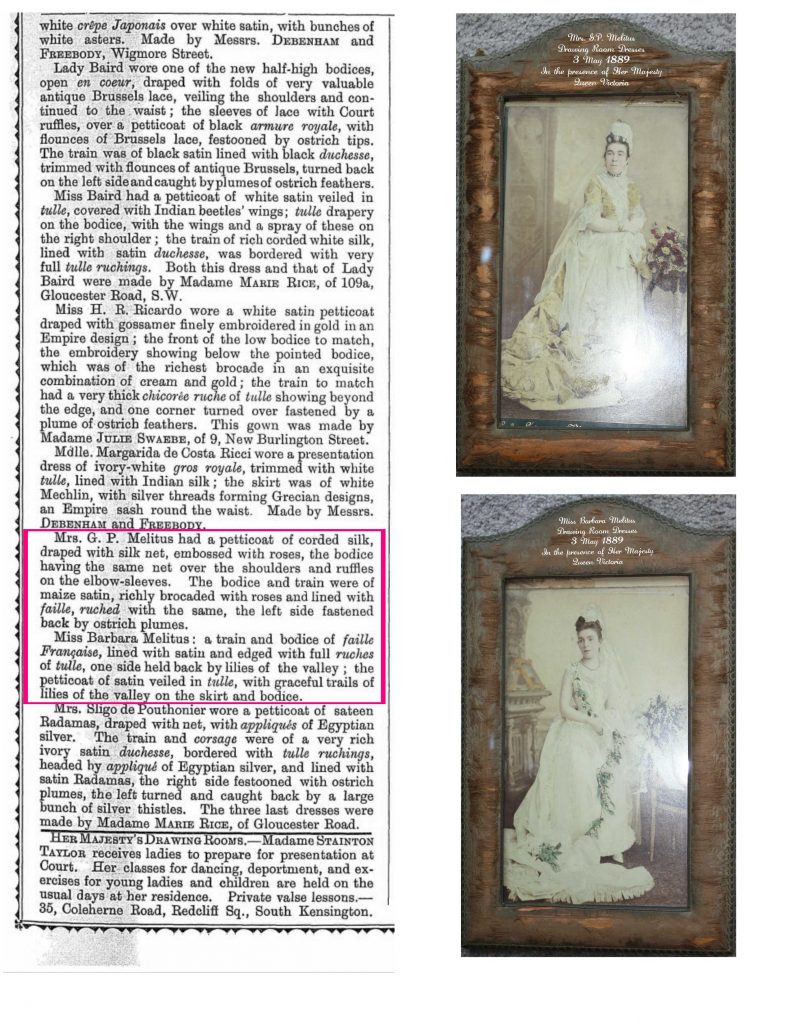
Meltius Drawing Room gowns. Mrs. Gregory Paul Melitus in the top picture is Mary (nee Elias). Her daughter Barbara below. Both were featured in the newspaper report.
The extraordinary thing about these pictures is that when Liz was shown them a few years ago, the owners didn’t know who they were or what the occasion was, just that they were “Melitus” ladies. With some time and a lot of patience she has been able to establish that they were in fact mother and daughter, Mary (wife of Gregory Paul Melitus) and Barbara Melitus.
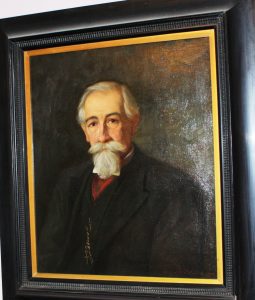
Original Oil Painting of Gregory Paul Melitus. Image: Liz Chater. Original painting owned by the Melitus family.
- Rosaline Stephen born in 1857, Dacca[21]
Rosie and her sister Kate (Catherine) both remained spinsters. As their parents Catherine and Johannes had passed away in 1861 and 1876 respectively, and their stepmother Annie had passed away in 1893, it would have been a daunting prospect to continue to live in India without immediate family around them. The Armenian community in Dacca was becoming smaller towards the end of the 19th/early 20th centuries, a number of whom were naturally migrating to England. Rosie and Kate made that choice as well, no doubt encouraged by their brother Kent. The sisters lived together in London at 26 Chepstow Villas, Bayswater. Kate died in 1926 before Rosie, who passed away in 1938. The two sisters are buried together at Mitcham Road Cemetery, Croydon, Surrey.[22]
In Rosie’s will she left the following bequests summarised as follows:
Furniture to be distributed according to Rosie’s written wishes in a separate letter, unfortunately these were not attached to my copy of the will.
£500 to niece Ellen Primrose Saunders
£500 to grand-niece Winifred Joan Newill
£500 to cousin Florence Macnaughten Stephen
£500 to be held in trust for grand nephew Michael Stephen[23] to be paid to him when he attains the age of 21. During his minority the income from the £500 is to be used for his education and maintenance.
An amount sufficient to provide a tombstone for her grave and to maintain the tombstones and graves of siblings, Mackintosh John Stephen and Kate Stephen as well as Rosie’s grave.
The residue of her estate to be invested and form the following trusts.
- one 4th part for “Our Dumb Friends League” 72 Victoria Street SW1
- one 4th part for “The Dogs Home” of 4 Battersea Park Road, SW8
- one 4th part for the School for the Blind Swiss Cottage NW3
- one 4th part for “The Friends of the Poor” Gentlefolks Department 40 Ebury Street SW1
There were very specific instructions that the leasehold on her residence of 26 Chepstow Villas was not be sold to the person or persons owning the freehold “even though such person or persons owning the freehold shall offer a higher price therefore than anyone else.”
In a codicil made and dated 29th April 1931, Rosie made the following changes, clearly reassessing her priorities:
“I revoke the legacies of £500 to Ellen Primrose Saunders and Winifred Joan Newill and instead bequeathed them £100 each.”
She re-confirmed the £500 legacy to her cousin Florence Macnaughten Stephen.
Rosie bequeathed to her maid, Winifred Victoria Pope £200 “as a memento of the faithful service and consideration she has shewn me”
Rosie revoked the legacy to Michael Stephen of £500 to be kept in trust and changed it to £100 to be kept in trust until he attained the age of 21.
- Carapiet Stephen born in 1858, Dacca
Carapiet or Carr Stephen married Ellen Nora Read in June 1883 at All Saints Church, Kensington.[24] They had two children:
Primrose Ellen Stephen born in Palace Gardens Terrace, Kensington in 1884[25] and Christopher Gerald Stephen born in Calcutta in 1890[26].
As can already be seen, Primrose was remembered in her Aunt Rosie’s will (above). In 1906 at Delhi, Primrose went on to marry Ernest Howie Saunders, a captain in the Royal Irish Rifles.[27] The marriage was witnessed by her mother Ellen who by that time had remarried to Montague Mark Noble[28]. Ellen’s first husband and father of Primrose had passed away in 1896 in Cawnpore,[29] where he was buried[30].
A few lines about Primrose’s husband Ernest. He was a highly regarded and decorated soldier who had been captured at Reddersburg South Africa on the 4 April 1900[31] and held as a prisoner of war with Winston Churchill and Lord Asquith during the Boer War.
He was born 18 November 1877, son of Colonel William Egerton Saunders, CB. He was educated at Dove’s College and then Sandhurst Military School when he passed out in 1894[32]. He entered the Royal Irish Rifles 8 September 1897, as Second Lieutenant, becoming Lieutenant in the Army 8 December 1899, and in the Royal Irish Rifles 24 February 1900. He served in the South African War, 1899-1902; employed with Mounted Infantry; took part in the operations in Orange Free State, March to April 1900; in the Transvaal, June to November 1900; also in Cape Colony, 1899 to 1900 mentioned in Despatches[33]; awarded Queen’s Medal with three clasps, and King’s Medal with two clasps. He was created a Companion of the Distinguished Service Order[34]: “Ernest Howie Saunders, Lieutenant, Royal Irish Rifles. In recognition of services during the operations in South Africa”. He was invested by the King 18 December 1902. On 8 September 1900, he was promoted to Captain in the Army, and on 24 November 1908 was transferred to the Indian Army, in which he became Major 1 September 1915.
QSA (3) CC OFS Trans (Lt, DSO RIR), KSA (2) (Lt, DSO RIR), 1914 Star and Bar (Capt, DSO, S&TC), BWM, Victory Medal with MID (Maj), 1911 Delhi Durbar.[35]
During WW1 Ernest sustained a gunshot wound to his knee. He was admitted to hospital in England where he convalesced for 10 months eventually being transferred to a military camp in Syria.[36]
As I watched the 75th anniversary commemorations for D Day in Portsmouth on the 5th and 6th June this year, I couldn’t help but think of Lt. Col. Ernest H. Saunders, although not a WW2 soldier he was ready to serve wherever he was required. In 1939 he declared he “was awaiting orders from the war office” and was conveniently living in Portsmouth, close to the military base, still wanting to “do his bit” for his country even though he was now in his 60’s. During his career he served his country with honour, dedication and commitment but his service record has faded as the years have passed by. It is ironic that he died alone in March 1956 in Portsmouth, Hampshire, with just a local roadsweeper and two military representatives attending his funeral.
From the newspaper obituary:
“A Lieutenant-Colonel who won the D.S.O. and was captured with Mr. Winston Churchill and Lord Asquith in the Boer War was buried yesterday week.
And his only close friend at the funeral was a roadsweeper.
The old soldier was Lieut-Col. Ernest Howie Saunders (78) of 120 Stubbington Avenue, North End, and his roadsweeper friend was Mr. R.Palmer, who since the death of Mrs. Palmer had taken over her duties and kept house for the Colonel.
“I knew the Colonel for 20 years” Mr. Palmer told a reporter.
“He had no relations apart from a daughter living in Kenya, so I have made all the funeral arrangements and for the time being, I am paying for them”.
The funeral did not pass completely unnoticed, however.Two ex-servicemen’s associations were represented.
The South African War Veterans’ Association by their Present Capt. R.R. Clay, and the Old Comtemptibles by their Vice-Chairman, Mr.J. Spillane.
Mr. and Mrs. S.P. Rainsdale, of the Portsmouth Golf Club were also at the funeral as the Colonel was one of the club’s original members.”[37]
Ernest came from an extraordinary line of military men, his father, grandfather and great grandfather were all highly decorated in the British Army and Navy respectively. This really was an appalling end for such a respected military veteran.
Ernest Saunders was buried in Milton Cemetery, Portsmouth, Hampshire on the 8th March 1956, reunited with his wife Primrose Ellen who had died on the 10th April 1938 at St. Mary’s Hospital Portsmouth of myocardial degeneration and pernicious anaemia[38]. She was buried on the 14th April 1938.
There was never a headstone placed on the plot for Primrose Ellen nor later Ernest, presumably the roadsweeper was unable to fund a memorial stone. Tragically this makes his illustrious career even more forgotten. The plot was never tended or remembered by either families and became abandoned very quickly. Portsmouth City Council reclaimed it in 1981 and used it for an unrelated burial of a female on top of the remains of Ernest and Primrose. It remains unattended, except for the cemetery grounds-men doing their general rounds.
Anyone wishing to pay their last respects to Lieutenant Colonel Ernest Saunders D.S.O., and Primrose can visit the unmarked grave at Plot T, Row 18, Grave 12.[39]
Ernest and Primrose’s daughter, Winifred was born in Meerut, India in 1909. Winifred was remembered in her great aunt Rosie’s will who bequeathed a legacy of £500. In a later codicil this was reduced to £100. Winifred married a military gentleman, Wilfred Marston Newill in Kensington, London in 1928.[40] She passed away in Perth, Australia in 1967[41], her husband Wilfred had passed away in Kenya in 1963[42].
Primrose’s mother Ellen, went on to have a least one child called Montague Horatio Nelson Aubrey [M.H.N.A.] Noble in 1897 with her second husband the highly ambitious forces veteran Montague Mark Noble. Montague Jr also joined the services and was awarded the Military Cross during WW1[43].
M.H.N.A.Noble was half-sibling to Primrose and Christopher who were twelve and six years old respectively when their father Carapiet Stephen died in 1896. As Ellen’s husband and the children’s step-father, Montague Noble took on the responsibility of parental guidance during their formative years, and it was his influence that was the driving force for his young step-son Christopher Stephen to join the military; it was the same path for his own natural son Montague. Contrary to popular belief, there was no military connection for Christopher’s Stephen line in India or Dacca. The Stephen’s were merchants not soldiers. Ultimately, Ellen outlived her highly decorated second husband Montague, he died in 1922 and is buried in the Brompton Road Cemetery in London. In his Will of 30 May 1918, Montague provided only for his widow Ellen, his son by her and any future issue his son may have, there were no bequests to his step-children Primrose or Christopher[44]. Ellen passed away in June 1931 and she is buried with her second husband in Brompton Road cemetery.[45]
- Catherine Stephen, born in 1860, Dacca
Kate remained a spinster and lived together with her sister Rosie at 26 Chepstow Villas, Bayswater. She passed away in December 1926 leaving all her estate to Rosie. The two sisters are buried together at Mitcham Road Cemetery, Croydon, Surrey
The children of Johannes Stephen’s second marriage with Annie Ter Martyrose were:
- Mkrtich Stephen, born in 1868, Dacca
Mkrtich anglicised his name and became known as Mackintosh John Stephen. A life long bachelor, having joined the Indian Postal Service in June 1893, he worked his way up through the ranks and in December 1895 was promoted to superintendent. Within a short time he was appointed personal assistant to the Deputy Postmaster General in Burma between November 1898 and March 1909. Further success came when he was promoted to deputy Postmaster General and Inspector General of the Railway Mail Service and Sorting in October 1913. A new appointment came in June 1918 as Deputy Postmaster General for Bengal and Assam and his final post was Postmaster General for Bihar and Orissa in July 1921. He retired to England in May 1924[46]. In his will dated 8th November 1928 he left a small legacy to a female friend in London, Miss Ruby Middleton and the remainder of his estate he left to his brother Stephen Paul Stephen with a note that under his discretion Stephen should distribute gifts to friends and family already mentioned to him verbally by Mackintosh[47]. He passed away in April 1929 in Brighton[48].
- Stephanos Stephen, born in 1870, Dacca
Stephanos anglicised his name and became known as Stephen Paul Stephen, he described himself as a mercantile merchant. Just like his siblings he too moved to London upon retirement where, as a bachelor, he lived in Pembridge Square, Notting Hill Gate. His net estate was valued at a modest £3,600 and apart from a small legacy of £100 to his brother Mackintosh, Stephen went to great lengths to ensure his old servant in India named as Bhikari Das in the village of Oltanga should receive Rupees 1,000[49]. Stephen died in April 1930 in Menton, France[50] and was the last surviving son of Johannes Stephen.
- Robert Abercrombie Stephen, born in 1872, Dacca
Robert began working for the Indian Government in May 1894[51]. Like his brother Mackintosh, he too rose through the ranks, became a magistrate and went on to be the deputy Commissioner for Excise and Salt in Bengal. Robert married twice, firstly to Ivy Sherman in Simla in 1908[52] and secondly to Vida Judd in 1919.[53] Robert died in the Calcutta General Hospital, Woodburn Ward of cardiac failure and was buried in the Lower Circular Road cemetery by Rev. E. Keeling of St. Thomas’s Church[54].
- Elizabeth Stephen, born in 1874, Dacca
Young Elizabeth lived only until she was eight years of age. She died in Barrackpore of pneumonia in 1882.[55]
Zemindar, Johannes Stephen died in Dacca in November 1876 of fever and piles.[56] Annie his second wife, died in 1893 in Allahabad of hepatitis and broncho pneumonia.[57]
Johannes had at least 6 siblings:
- Catherine, born 1825, remained a spinster, died in Barrackpore 1907.[58]
- Kent Hume Stephen, born 1830, Dacca. Became a deputy magistrate. Died at Singapore on his way to Hong Kong January 1868.[59]
- Carr Stephen, born 1835, married Rosamond Eleanor Parry in Delhi in 1870[60]. They went on to have at least five children:
Catherine Julie Stephen[61];
Alice Isabel Mary Stephen[62];
Carr St. John Stephen[63];
Robert Hume Stephen[64];
Florence McNaughten Stephen[65].
Carr Stephen was a barrister, passing the Bar exam in June 1866. He rose to become a judge in the small cause court in the Punjab. He published three books: “Indian Registration Act”, “Handbook for Delhi” and “Archaeology of Delhi”. Carr died in Delhi in 1891 of heart disease[66]. Meanwhile his wife Rosamond had set sail from London in December 1887[67] on the vessel “Port Piri” en route to Las Palmas in the Canary Islands taking her young children, Alice aged 12, Carr aged 9, Bertie aged 7 and Florence aged 3 years with her. Having arrived in early February 1888, the family were there less than a month when Rosamond passed away on the island[68]. It would appear Rosamond’s own extended and complicated step-family in England may well have taken the children under their wing. The children were educated in England; Alice and Florence in Suffolk, whilst Carr and Robert were schooled in London. Carr became a travelling salesman whilst Robert devoted himself to his religious beliefs and became a clergyman. Alice took vows and became a nun at the Convent of Poor Clares, Herefordshire and although nothing is known of Florence, she was clearly in the thoughts of her cousin Rosaline Stephen who had written her will in 1931 and left a small legacy to her.
- Aratoon Johannes Stephen, born 1836. Married Mary Sarkies in February 1860 at the Armenian Church Dacca.[69] They had at least five children:
St. George Kent Hume Stephen 1861[70];
Jan Denkin Stephen 1862[71];
Gulnabath Stephen 1863[72];
Arratoon St. John Stephen 1875[73];
Margaret Stephen 1877[74].
During the early 1880s Aratoon Johannes Stephen, a landholder, had lived at the Chowringhee Hotel in Kolkata. Embroiled in litigation in which he tried to defend a case where he had taken a loan from a money lender in Kolkata in the name of his eldest son, he lost and was declared insolvent. He made attempts to clear his debts, but was unsuccessful and then as the Sub-Editor of ‘The Statesman’ he was again declared insolvent 1887. By 1889 his Official Assignee declared a small dividend payment to his creditors. He continued to work as the Sub-Editor of The Statesman until his death in 1900 in Calcutta. He was buried in Park Street cemetery[75].
- Mackertich Stephen born 1837, studied law and passed the Bar exam at Lincoln’s Inn. The attached rare letter[76] signed in a very unsteady hand by him and dated just a month before he died, makes one wonder if he was attempting to get his personal affairs in order. He died a bachelor on the 3rd June 1867 in Dacca and is buried in the compound of the Armenian Church[77].
- William Stephen[78]. Nothing is known about him.
Their parents were Johannes Stephen Snr. (born 1790 Julfa) and Goolnabad.
Johannes Snr married twice, first to Goolnabad around 1822, she passed away in Dacca in January 1838 aged 35 years[79] and is buried in the grounds of the Armenian Church. He quickly remarried in December 1838 to Sultana Athanes, granddaughter of Alexander Panioty who was the doyen of the Greek community of Dacca. She passed away in January 1843 and is buried in the Armenian Church compound in Dacca.[80]
Johannes Stephen Snr had two sisters, Catherine and Mariam who were also based in Dhaka.
Catherine[81] married Gregory Thorose, a tide waiter with Calcutta Customs around 1812. They had two daughters Huripsimah Regina Thorose Gregory and Nanajan Nanook Thorose Gregory.
Mariam had married 3 times, all in Dhaka[82], firstly to Martyrose Kaloos, secondly to Arratoon Michael (from whom she had inherited on a large scale) and thirdly to an Englishman Edmund Kent Hume[83]. All three marriages were childless. After her death in 1833, her brother Johannes Stephen Snr began court proceedings against her 3rd husband Edmund for a share of her estate. He failed and Edmund inherited her wealth. He went on to marry again to Pheunnah Honor McClean in 1845[84]. Pheunnah died on the 15th September 1849 and Edmund the following day. They were both buried in the Christian cemetery at Dhaka.
To give you an idea of Mariam’s wealth, here is a selection of her properties in Dacca at the time of her death.
This example of the Stephen family network is a perfect illustration of how quickly the Armenian connection was lost in Dhaka as families naturally migrated to larger cities with more opportunities. Land disputes, litigations and lack of prospects all had a negative impact, yet those who did stay believed they could make a go of it.
Today, there are no Stephen’s left in Dhaka, their lands in and around the city are long gone; broken up in to smaller pieces and parcels and now heavily built upon. The numerous descendants of Johannes Stephen Snr and his siblings are living all over the world and some of them won’t even know of their connection to Dhaka or their Armenian heritage.
In 1831 those 126 Armenians had no idea of the history and legacy they were leaving behind. Today, our focus is on preserving the Church and helping the local Dhaka people in every way we can. We continue to build on those early foundation stones maintained over the last 200 years by extraordinarily selfless custodians to whom we are all very grateful. The Armenian Church in Dhaka stands today because of this small, but fiercely strong and determined community whose presence over the centuries and decades has been an integral part of Dhaka life.
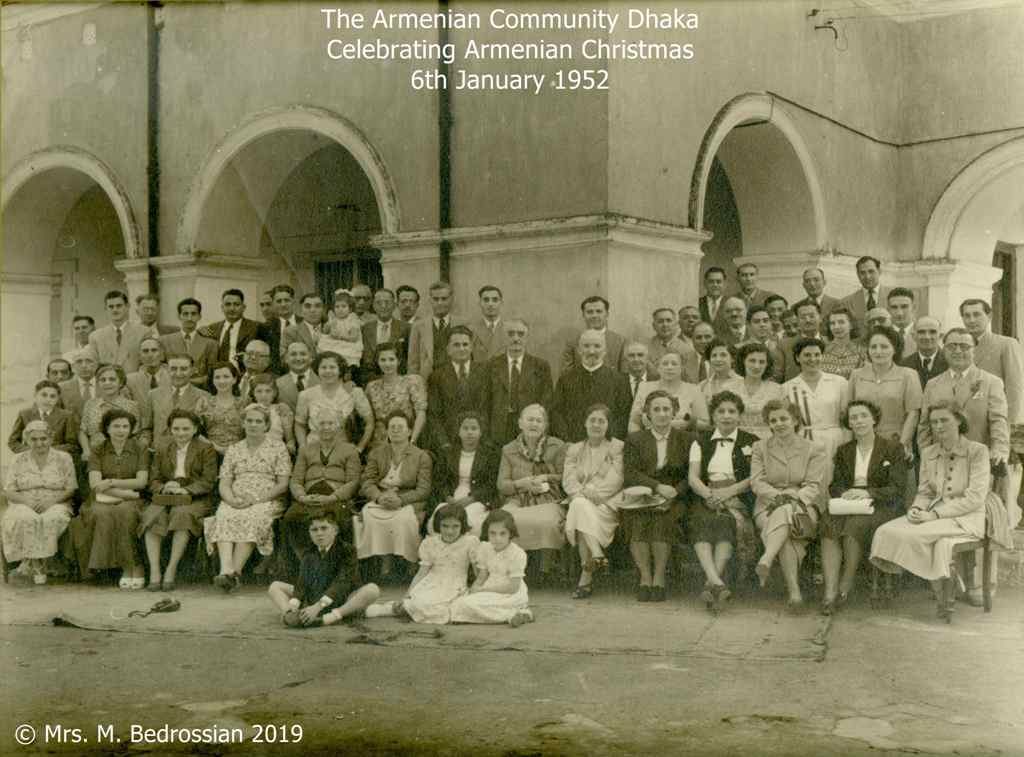
The Armenian Community Dhaka Christmas 1952. Image: Armenian Heritage project Bangladesh. Courtesy of Mrs. M. Bedrossian.
Liz Chater is the coordinator and researcher for the Armenian Heritage Project Bangladesh.
The project is still accepting contributions, and is keen to reconstruct the history and family stories of the Armenian presence in Bangladesh. The project has already received material from contributors in the USA, Canada, UK, Australia and India. If you have something you would like included, please get in touch via our social media pages, Facebook, Twitter, Instagram or website www.armenianchurchbangladesh.com.
Sources:
[1] Gleanings in Science, Jan-Dec 1831 Vol.3
[2] The Friend of India September 1853
[3] The Friend of India 8 September 1853
[4] The Friend of India 26 December 1861
[5] Marriage record N1-122-81
[6] British Consulate Marriages, Geneva 1810-1968
[7] The Homeward Mail April 1867
[8] The Homeward Mail December 1875
[9] Allen’s India Mail 17 October 1854
[10] Armenian Church baptism register No. 74
[11] The Ipswich Journal January 1879
[12] Men At The Bar, P.446
[13] Report of the Managers of the Armenian College & Philanthropic Academy 1901
[14] Burial record N1-407-129
[15] His Will. L/AG/34/29/161/15
[16] Armenian Church baptism register No. 83
[17] The Morning Post June 1895
[18] The Times of India November 1868
[19] UK Civil Engineer Records 1820-1930
[20] Original document held by the Melitus family, photographed by Liz Chater in 2011 and reproduced with permission
[21] Armenian Church baptism register No. 90
[22] The Times May 1938
[23] Michael was the son of Christopher Stephen, who was the son of Carr Stephen, Carr was Rosie’s brother.
[24] Marriage certificate
[25] Birth certificate
[26] Baptism record N1-214-264
[27] Marriage record N1-335-56
[28] Marriage record N3-76-81
[29] Times of India 1896
[30] Miscellenea Genealogica et Heraldica. On a recumbent marble cross: “In loving memory of CARR STEPHEN the third son of John Stephen Esqr of Dacca, born 20th December 1858, died 3rd February 1896, aged 37 years.”
[31] South African Field Force Casualty Role
[32] Dove’s College Register 1871-1899
[33] London Gazette 10 September 1901
[34] London Gazette 27 September 1901
[35] See the AngloBoerWar website for biography
[36] British Armed Forces, First World War Soldier’s Medical Records MH 106/1221
[37] Hampshire Telegraph and Post 16 March 1956
[38] Death certificate
[39] Portsmouth City Council, Registrar of Cemeteries
[40] Marriage certificate
[41] Australian Death Index
[42] Kenyan Gazette 23 March 1964
[43] Haileybury records
[44] His will L/AG/34/29/180
[45] Burial record Brompton Cemetery, Plot 2E/40.9/20.9
[46] UK Registers of Employees of the East India Company. India Office List.
[47] The Will of Mackintosh John Stephen
[48] England and Wales death index
[49] The Will of Stephen Paul Stephen
[50] National Probate Calendar
[51] Deaths in the Uncovenanted Service. L/AG/34/14A/12
[52] Marriage record N1-349-67
[53] Marriage record N1-441-103
[54] Burial record N1-445-340
[55] Burial record N1 182-188
[56] Burial record N1-158-289
[57] Burial record N1-228-156
[58] Times of India 1907
[59] Times of India 1868
[60] Marriage record N1-131-423
[61] Baptism record N1-147-20
[62] Baptism record N1-155-64
[63] Baptism record N1-173-66
[64] Baptism record N1-173-66
[65] Times of India 1883
[66] Burial record N1-216-403
[67] Victoria, Australia, Assisted and Unassisted Passenger Lists, 1839-1923
[68] GRO Overseas Deaths
[69] Armenian Church Dhaka Marriage Register No. 22
[70] Armenian Church Dhaka Baptism Register No. 109
[71] Armenian Church Dhaka Baptism Register No. 118
[72] Armenian Church Dhaka Baptism Register No. 125
[73] Armenian Church Kolkata Baptism Register No. 1557
[74] Armenian Church Kolkata Baptism Register No. 1558
[75] Burial record N1-285-15
[76] From the private archive of Liz Chater
[77] Armenian Church Dhaka Burial Register No. 87
[78] Name extracted from Indian Decision (Old Series) Vol VIII
[79] LDS film 1356948 items 3. Also her grave
[80] Armenian Church burial Register No. 21
[81] Will of Mary Hume
[82] Law Report: Indian Decision 30 November 1841 No. 63
[83] Marriage record N1-24-111
[84] Marriage record N1-67-58

